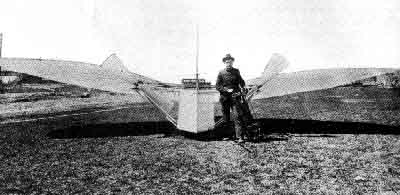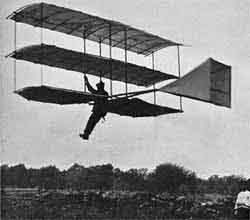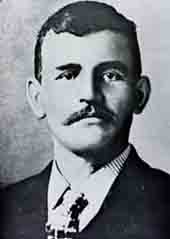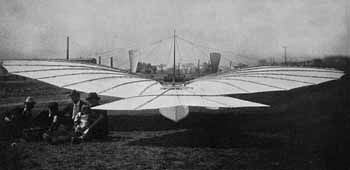pop up description layer
HOME
Cryptozoology UFO Mysteries Aviation Space & Time Dinosaurs Geology Archaeology Exploration 7 Wonders Surprising Science Troubled History Library Laboratory Attic Theater Store Index/Site Map Cyclorama
Search the Site: |
|
Gustave
Whitehead: Did He Beat the Wright Brothers into the Sky?
Whitehead, who Americanized his name from Weisskopf when he immigrated from Bavaria, Germany, was a mechanic by trade who lived and worked in Boston, New York, Buffalo, Tonawanda, Johnstown, Pittsburgh, and finally Bridgeport, Connecticut around the turn-of-the-century. According to at least one biography, Whitehead was fascinated by aviation from an early age and was inspired by the glider flights of Otto Lillienthal to built his own model glider at age 13. Skeptics point out this is surely a mistake or exaggeration since Whitehead was 13 in the year 1887, well before Lillienthal started his glider experiments. According to an article in the January 1935 edition of Popular Aviation written by Stella Randolf and Harvey Phillips, Whitehead made his first flight in a steam-driven aircraft just outside Pittsburgh in the spring of 1899. Two years later, in August 1901, he made another flight with a gas-powered plane (which he designated as "Number 21") near the town of Bridgeport, Connecticut. In 1902 he made a flight with an aircraft numbered "22" that flew over Long Island Sound. If true, these flights would have meant Whitehead proceeded the Wright Brothers into the air by at least one, or maybe even three years. Unfortunately there is little information or evidence about the existence of the Pittsburgh flight. The account in Popular Aviation tells us that Whitehead hadn't expected the new airplane to go as far as it did, and he crashed into a building, destroying the craft: But as they went onward and upward, steered by Gustave Whitehead at the controls in the front, they exceeded the distance originally planned and found themselves headed for a three-story brick house. Afraid to attempt to swerve, there was but one hope, namely that they might clear the top of the house. But they failed. Down fell the machine, all but demolished, while the agonized fireman in the back writhed with the pain of a scalded leg. The glasses for indicating water-level in the boilers had broken, permitting steam to envelop the man.
Even the most ardent Whitehead supporters admit that proof of the Pittsburgh experiment is lacking. More evidence is available of the Bridgeport flights, though. The plane Whitehead constructed at Bridgeport was, according to the Popular Aviation article: ...a monoplane with a four-cylinder two-cycle motor located forward. Ignition was of the make and break type and Columbia dry batteries were used. The gas tank was gravity-fed and held two gallons of petrol. The body of the machine was constructed of pine, spruce, and bamboo, reinforced with Shelby steel tubing and piano wires. The wing coverings were of Japanese silk, varnished and fastened to the bamboo struts with white tape. The wings spread out behind the two propellers, and were supported with wires running to a central mast. The entire thing weighed approximately 800 pounds. With Mr. Whitehead aboard the weight was increased to about 965 pounds. On August 14, 1901, or so the story goes, Whitehead made a test flight near the location which was later to become the Sikorsky airplane factory. He flew the machine for one and a half miles that day. According to the Popular Aviation article the authors interviewed Junius Harworth, who had been a young boy assisting Whitehead. Harworth said he remembered the flight distinctly and in detail. The next January Whitehead was ready with a new machine, which he tested on the 17th. Again Popular Aviation: Gustave Whitehead took his place at the controls of the machine, the men gave it a preliminary push, and it trundled away on its three wheels and was off! The plane performed so admirably that its owner continued his flight for a distance of two miles over the Sound, following the shore line of the beach, although he had intended to make only short flights of not more than half a mile. The men pulled it ashore, and now Gustave Whitehead proposed to fly across the Sound. According to the article Whitehead never made it across the Sound, but turned back, deciding to test the ability to turn the plane instead. As interesting as the assertions in the Randolf and Phillips article were, they were written more than three decades after the incidents depicted and nine years after Whitehead's death in 1927. Evidence more contemporary to the events would be helpful in establishing the truth of the matter. This came in the form of an article in The Bridgeport Herald newspaper from August 18, 1901. The author states he witnessed a night test of the plane, at first unpiloted but loaded with sand bags, and later with Whitehead at the controls. Such a news report would seem clinching evidence that the flight had taken place, yet skeptics point out that the story has holes in it. The first is that the aircraft was tested early in the morning before sunrise. With primitive flying technology getting a plane into the air would be dangerous during the day and certainly suicidal at night. Also, the idea that the plane could be tested with no pilot, but only sand bag ballast seems absurd. Early flying machines were tricky to handle and an unpiloted test flight would almost certainly have resulted in a crash. Why would a newspaper report a successful flight if it didn't really occur? Though it has virtually disappeared from the mainstream newspaper business, in the 19th and early 20th century hoax journalism was widely practiced. For this reason outlandish stories dating from that period cannot be taken at face value. It would not be inconceivable at all that a reporter looking for a story might have come across Whitehead and his flying machines and decided to say that he actually witnessed a test flight that had never occurred. How do we know that Whitehead built airplanes at all? On that point there is some pretty solid evidence. There are a number of photos showing Whitehead with different flying machines that he'd constructed. Unfortunately none of them show any of his powered machines actually up in the air, though they do confirm that one of his gliders flew. Such a photo of a powered-flying machine would have gone a long way toward proving Whitehead's claims.
Other evidence that would establish Whitehead's success at getting into the air would have been plans of the aircraft he built along with notes or letters documenting the progress of his aviation experiments. Whitehead, except for a few letters to Scientific American about his flights, left no paper trail to follow. Of course, Whitehead's supporters point out that the German immigrant was not a man a letters, but a mechanic, and the fact that he simply did not bother to document his flights does not mean that he did not actually make them. In 1936, after the Popular Aviation article appeared, The Harvard University Committee on Research in the Social Sciences sent John Crane, a professor of economics, to Connecticut to get to the bottom of the story. Crane published his conclusions in an article in the National Aeronautical Association Magazine in December 1936 entitled "Did Whitehead Actually Fly?" According to Crane, after interviewing many Bridgeport residents and Whitehead's family, he only found one person who remembered the flights and that person had a financial interest in a book that Stella Randolf was writing on Whitehead. It seems impossible to establish positively from the historical record that Whitehead made the flights, but can we know if his designs were capable of flight? There have been several attempts to rebuild some of Whitehead's aircraft and fly them. In the late 1980's a group studied pictures of number "21" and drew up plans for an aircraft based on them. These plans were then used by The Historical Flight Research Committee Gustave Whitehead (HFRC-GV) in Germany to build an aircraft which was successfully flight tested in 1997. While the test shows that Whitehead's design might have flown, it does not prove that it actually did. Without plans drawn up by Whitehead himself, there is no way of knowing for sure if the reproduction was truly accurate. Also, the reproduction aircraft used a modern "unltralight" engine and propeller which probably produced significantly more thrust than the Whitehead's original engine/propeller combination would have had. Since engine weight vs. power was a significant hurtle for early aviators, this alone might have rendered a workable aircraft design unflyable. Whitehead supporters point to an unusual deal made between the Smithsonian Institution and the Wright Brothers estate as one of the reasons why information about Whitehead's flights were suppressed. Though the Wright Brothers are generally recognized as the first to build a successful powered airplane today, that was not the case in the early 1900's. The Wright Brothers fought to protect their patents while other airplane builders tried to find either ways around the patents or ways to make them invalid. Glenn Curtiss rebuilt an experimental airplane designed by Samuel Langley of the Smithsonian Institution to try and show that other aircraft could have flown before the Wright's Flyer did. This caused a schism between the Smithsonian Institution and the Wright Brothers and for this reason the Flyer was not exhibited in the Smithsonian until 1948. When it finally was, it was only with the agreement that: Neither the Smithsonian Institution or its successors, nor any museum or other agency, bureau or facilities administered for the United States of America by the Smithsonian Institution or its successors shall publish or permit to be displayed a statement or label in connection with or in respect of any aircraft model or design of earlier date than the Wright Airplane of 1903, claiming in effect that such aircraft was capable of carrying a man under its own power in controlled flight.
Whether without this agreement the Smithsonian would have really come to the conclusion that Whitehead flew first is purely a matter of speculation. It has, however, added to the feelings among Whitehead supporters that there has been a conspiracy not to give him his just rewards. So did Gustave Whitehead really beat the Wright Brothers into the sky? This is an issue that is never likely to be settled to everyone's satisfaction. Clearly the evidence for his flights are too thin to overturn the Wright's Brothers place in the minds of most historians. However, there are a lot of people who believe, and will continue to believe, that Whitehead was successful in getting an aircraft into the air several years before the Wright's Flyer left the ground at Kitty Hawk in December of 1903. It is interesting for the rest of us to consider whether the history of flight might be considerably changed if someone had thought to bring a camera to an empty field outside of Bridgeport early one morning in 1901. |
|
Related Links |
|
|







